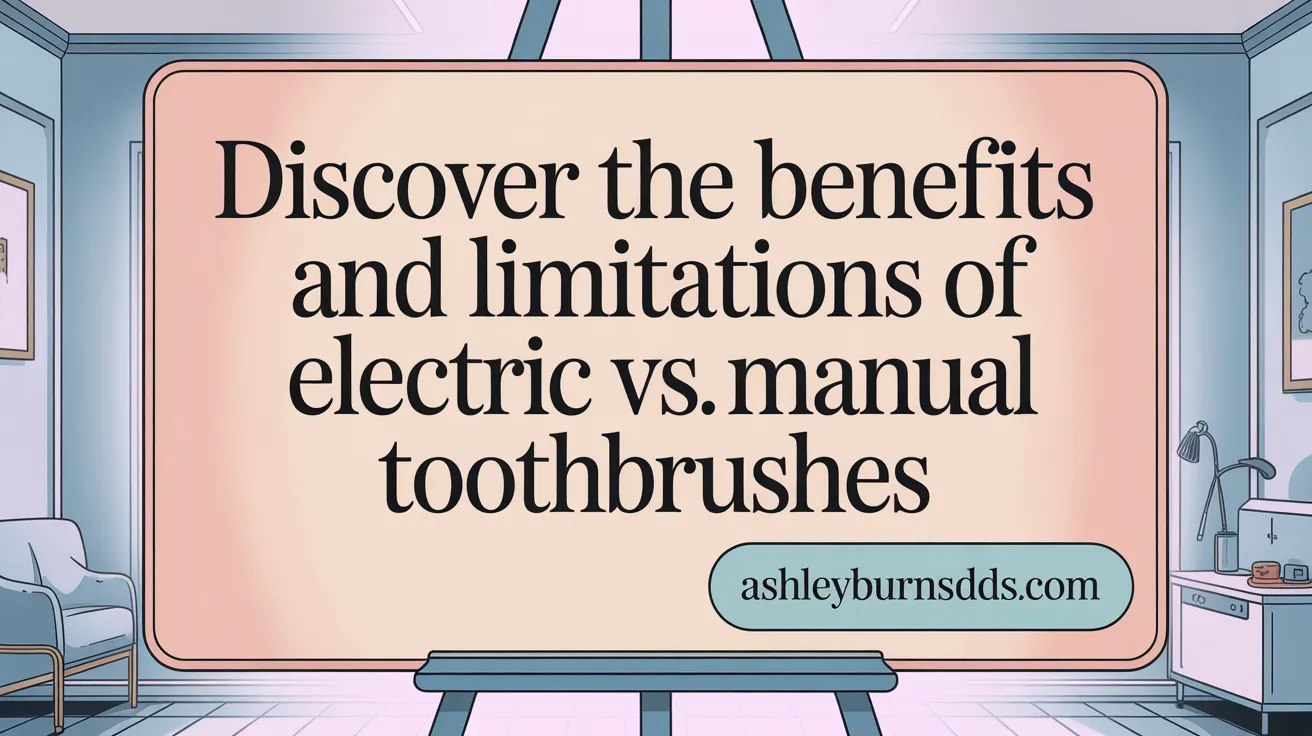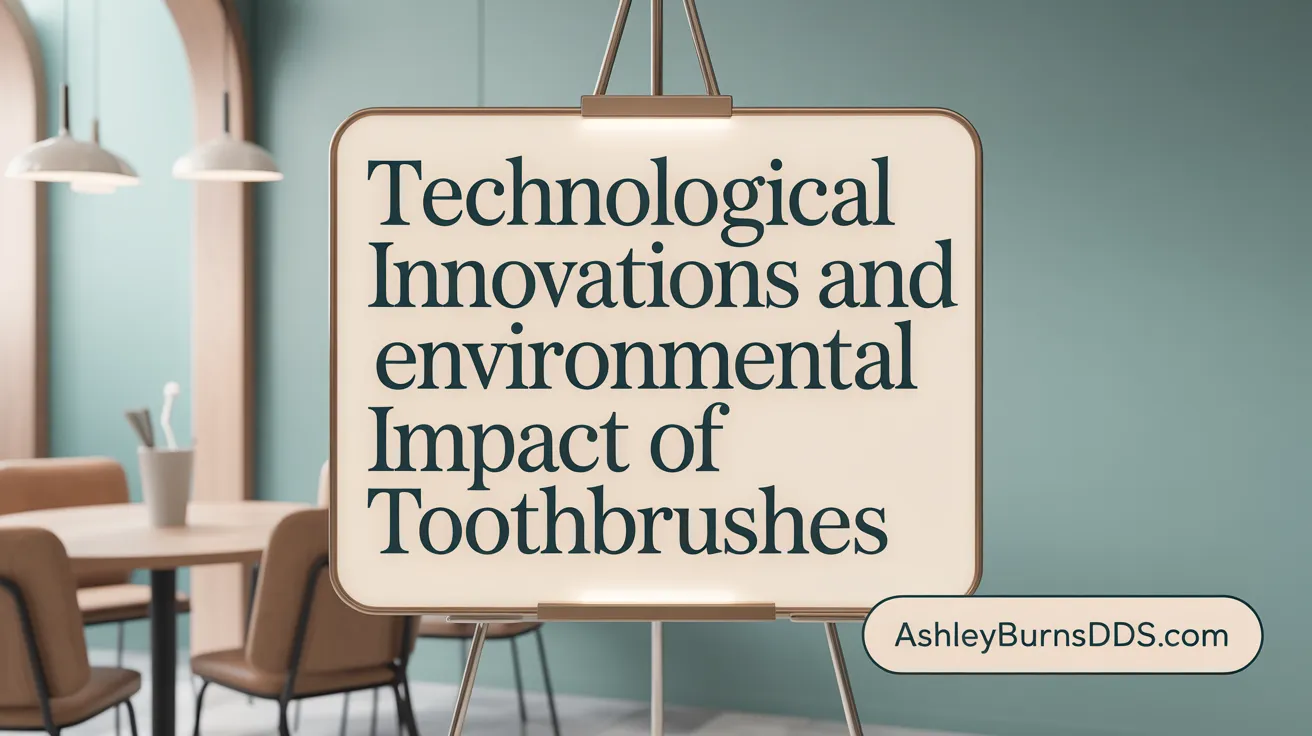Choosing the Right Tool for Your Smile
Selecting between an electric and a manual toothbrush is a common dilemma faced by many seeking optimal oral care. Both options have their merits and drawbacks, influenced by individual needs, dental conditions, and lifestyle. This article explores the differences, effectiveness, features, and professional recommendations to help you make an informed choice for maintaining a healthy smile.
Understanding the Key Differences and Effectiveness of Toothbrush Types

What is the difference between electric and manual toothbrushes?
The primary distinction lies in their operation: electric toothbrushes feature motorized bristles that perform rapid, automated motions, whereas manual toothbrushes rely solely on the user’s hand movements. Studies have consistently shown that electric models tend to remove more plaque—about 21% more after three months—and can more effectively decrease gingivitis and slow periodontal disease progression. Features like built-in timers, pressure sensors, and multiple brushing modes in electric toothbrushes help users adopt better brushing habits and prevent over-brushing. These tools are particularly advantageous for individuals with limited dexterity, orthodontic appliances, or other dental concerns, making cleaning more efficient and effortless. (source)
Effectiveness in plaque removal and gum health
Electric toothbrushes excel in plaque removal and gum health improvement due to their high-speed, consistent brushing action. Clinical trials indicate that they are more effective than manual brushes in reducing plaque buildup and gingivitis, especially with oscillating-rotating technology. For example, studies have reported that powered brushes achieve around 11% plaque reduction at 1-3 months with greater improvements seen over longer use. (source)
Scientific research insights
Research consistently supports the superior performance of electric toothbrushes, especially oscillating-rotating types, over manual ones. Several large-scale, randomized clinical studies have shown significant benefits, including reductions in plaque, gingivitis, and gum recession. Long-term studies, such as an 11-year German investigation, revealed that electric toothbrush users retained more teeth and experienced less periodontal disease progression. Meta-analyses affirm that power toothbrushes provide a scientifically validated advantage, promoting better oral hygiene outcomes overall. (source)
How each type impacts oral health
Both manual and electric toothbrushes can maintain good oral health if used properly. Manual brushes offer the benefit of simplicity, portability, and lower cost, making them accessible for most people. Technique remains critical; gentle, thorough brushing at a 45-degree angle, for two minutes, is essential regardless of the tool. (source)
Electric toothbrushes, on the other hand, facilitate consistent, effective brushing, especially for those who struggle with manual dexterity or need more guided cleaning. They help minimize gingival damage by signaling the user to avoid excessive pressure and ensure complete coverage of all mouth areas. Overall, individual preferences, proper use, and consistent routines are vital, with evidence favoring electric toothbrushes for more efficient plaque control and gum health enhancement. (source)
Advantages and Drawbacks: Comparing Electric and Manual Toothbrushes

What are the advantages of electric toothbrushes over manual toothbrushes?
Electric toothbrushes provide substantial benefits, especially in terms of cleaning efficiency. They utilize advanced oscillating-rotating technology or sonic mechanisms that can remove up to 70% more plaque than manual brushes, particularly in hard-to-reach areas. Clinical studies support that electric brushes reduce plaque, gingivitis, and gum recession, and they can slow down periodontal disease progression over many years (effective plaque removal and gingivitis reduction, long-term dental health study). The built-in features like timers, pressure sensors, multiple cleaning modes, and Bluetooth connectivity promote proper brushing habits, helping users meet the recommended two-minute brushing time effortlessly. They are especially user-friendly for seniors, children, and individuals with limited manual dexterity, enabling more thorough cleaning with less effort (ease of use for limited dexterity, benefits for people with limited dexterity. Despite higher initial costs, their technological advantages and ease of use contribute significantly to maintaining optimal oral health.
What are the advantages of manual toothbrushes over electric toothbrushes?
Manual toothbrushes are highly accessible due to their affordability and simplicity (manual toothbrush affordability, cost-effective dental care. Priced as low as a few dollars, they are widely available at grocery stores, pharmacies, and even during travel. They do not require batteries, charging, or replacement technology, making them straightforward and convenient to carry and use anywhere (manual toothbrush portability, travel convenience). Manual brushes are also environmentally friendly if made from biodegradable materials (eco-friendly manual toothbrush options) and allow full control over pressure, angle, and brushing technique (proper manual brushing technique. For many users, proper brushing with a manual toothbrush—using soft bristles and following recommended techniques—can be just as effective as electric ones when practiced consistently (manual vs electric effectiveness). Their low cost and portability make manual toothbrushes a practical choice for budget-conscious individuals or travelers.
What are the disadvantages and potential drawbacks of electric toothbrushes?
Despite their effectiveness, electric toothbrushes have some drawbacks. They tend to be more expensive initially and for replacement heads, which may be a barrier for some users (cost considerations, replacement head costs). Their electronic components make them susceptible to damage from water exposure or mechanical impacts, possibly leading to malfunction and inconvenience (risks of using electric toothbrushes). Over-brushing remains a risk; if used aggressively, they can cause gum irritation, recession, or enamel damage, emphasizing the need for gentle technique (electric toothbrush abrasion risks, sensitivity from electric brushing. The bulkiness and weight of certain models may be uncomfortable for some users, especially during travel or for those with limited grip strength (comfort and convenience issues). These disadvantages highlight that while electric brushes offer enhanced cleaning power, proper use and maintenance are essential to avoid potential issues.
What are the disadvantages and potential drawbacks of manual toothbrushes?
Manual toothbrushes, although affordable and simple, have limitations in cleaning efficacy, especially if not used with proper technique such as sufficient duration and gentle pressure (manual toothbrush effectiveness. They lack technological features like timers and pressure sensors, which help ensure effective and safe brushing (absence of timers in manual brushes). This can lead to inconsistent cleaning, over-brushing, or inadequate coverage of all surfaces. For individuals with disabilities or arthritis, manual brushes can be difficult to maneuver properly, reducing their effectiveness (limitations for people with arthritis). Furthermore, manual brushes do not provide feedback or cues to improve technique, which can result in less optimal oral hygiene. Their effectiveness enormously depends on user skill and discipline, making them less foolproof compared to powered options (reliance on manual skill).
Proper Techniques and Features to Look For in Both Toothbrush Types

What is the proper use and technique for both electric and manual toothbrushes?
Proper brushing technique is essential for maintaining good oral health, regardless of the type of toothbrush used. For manual brushes, it is recommended to hold the toothbrush at a 45-degree angle to the gumline and use gentle circular or back-and-forth strokes, covering all surfaces—front, back, chewing surfaces, and the inner side of teeth. Avoid applying excessive pressure to prevent gum damage and enamel wear. The goal is to brush for at least two minutes twice daily.
Electric toothbrushes simplify the process by automating the brushing motions. Users should guide the brush slowly over each tooth, maintaining a light grip, roughly holding it with fingertips. The brush should be kept at a 45-degree angle toward the gums, and many models include timers and pressure sensors to assist in proper technique. Replacing brush heads every three to four months and including thorough cleaning of tongue and palate enhance overall effectiveness.
Consistently applying proper technique helps reduce plaque and gingivitis and improves overall oral health. Good habits such as flossing and using fluoride toothpaste further support dental wellness.
What features should one look for in electric toothbrushes?
When selecting an electric toothbrush, certain features can significantly improve its effectiveness and usability. A built-in timer ensures that you brush for the recommended two minutes, while a pressure sensor alerts you if you are brushing too hard, preventing gum recession and enamel damage. Multiple brushing modes, such as sensitive, whitening, or gum care, allow customization to specific oral health needs.
Rechargeable batteries with a long lifespan—ideally lasting a week or more on a single charge—add convenience. For children or those new to electric brushes, engaging features like colorful designs, characters, or app connectivity can make routine more appealing.
Compatibility with replaceable brush heads is important to maintain hygiene and reduce waste. An ergonomic handle with a comfortable grip facilitates better control during brushing. Consulting with a dental professional can help identify features that best suit your oral health status.
What features should one consider in manual toothbrushes?
Manual toothbrushes should have soft or ultra-soft bristles to minimize harm to gums and enamel while effectively cleaning teeth. Bristle configuration—whether flat, angled, or multi-level—can help target plaque in hard-to-reach areas.
An ergonomic handle with textured grips or finger supports improves control, especially for individuals with limited dexterity. A smaller, appropriately shaped head enables easy access to tight spaces and around dental appliances like braces.
Durability and ease of replacement are also important—regularly changing your toothbrush every three to four months ensures that cleaning remains effective. Opting for brands with the ADA Seal of Acceptance guarantees safety, efficacy, and quality.
Choosing the right toothbrush and technique, combined with regular professional dental care, supports healthy teeth and gums, reducing the risk of cavities, gingivitis, and more serious periodontal issues.
Professional Recommendations and Considerations for Choosing the Right Toothbrush

What recommendations do dental professionals give when choosing between electric and manual toothbrushes?
Dental professionals generally suggest that both manual toothbrushes and electric toothbrushes can be effective at maintaining oral health if used properly. However, they often recommend electric toothbrushes for individuals seeking improved plaque removal, those with limited manual dexterity, or people with dental appliances like braces. Features such as built-in timers and pressure sensors in electric models help encourage proper brushing duration and technique, reducing the risk of gum damage.
The American Dental Association (ADA) emphasizes that the most important factor is consistent, correct brushing, regardless of toothbrush type. For best results, using soft bristles and replacing brushes every three to four months is advised to prevent bacterial buildup and ensure gentle, effective cleaning.
What considerations such as cost, convenience, and suitability should be made when choosing between electric and manual toothbrushes?
When deciding between the two, consider factors such as initial purchase and replacement costs—the latter being higher for electric models due to replaceable heads. Convenience aspects include ease of travel, since manual toothbrushes are more portable, don’t require charging, and are generally more discreet.
Personal dexterity or physical conditions like arthritis or gum sensitivity also influence suitability. Electric toothbrushes are easier for those with limited hand mobility and can prevent over-brushing thanks to built-in pressure sensors. Conversely, manual brushes are cost-effective, environmentally friendly, and don’t depend on power sources.
What are the comparative benefits of electric and manual toothbrushes for specific dental needs, such as receding gums or tooth sensitivity?
For specific needs such as receding gums or sensitive teeth, electric toothbrushes equipped with gentle modes, smaller heads, and pressure sensors can be advantageous. They help provide effective cleaning without applying excessive force that might worsen gum recession or cause discomfort.
Manual toothbrushes offer greater control over pressure, making them suitable for those with very sensitive gums when used carefully. Nonetheless, research indicates that electric toothbrushes tend to accomplish better plaque removal and gum health improvements over time, especially with features designed for sensitive areas.
How can someone make an informed decision between electric and manual toothbrushes based on effectiveness, safety, and personal preferences?
Making an informed choice involves evaluating personal needs, preferences, and professional advice. Electric toothbrushes can aid in better plaque removal, promote consistent brushing with timers, and reduce the likelihood of gum injury through pressure sensors.
Manual toothbrushes, when used with proper technique, can be just as effective and are more affordable and portable. Both options require diligent brushing for two minutes twice daily and regular replacement of brushes.
Consulting your dentist can provide personalized guidance, especially if you have specific concerns like gum recession or limited mobility. Ultimately, selecting a toothbrush that you are comfortable using consistently is crucial for maintaining optimal oral health.
Additional Insights: Technology, Environmental Impact, and User Experience

How have technological advancements improved electric toothbrushes?
Modern electric toothbrushes now feature sophisticated technology such as real-time tracking, Bluetooth connectivity, and various cleaning modes tailored to specific needs like sensitive teeth or whitening. Models like the Philips Sonicare 9900 integrate AI to suggest optimal brushing techniques, helping users maximize oral health benefits. Features like pressure sensors also alert users when they are brushing too hard, preventing damage to gums and enamel. These technological improvements make electric toothbrushes more effective and engaging.
What are the environmental and practical considerations?
While manual toothbrushes are biodegradable and environmentally friendly, electric toothbrushes involve electronic components and replaceable plastic heads, raising concerns about waste. However, eco-friendly options like bamboo manual brushes or recyclable electric brush bodies are emerging. Practically, electric toothbrushes require charging and replacement heads, which entail ongoing costs but can reduce plastic waste when replacing only the brush head rather than the whole device (cost and maintenance).
How does user comfort and engagement vary?
Many users find electric toothbrushes more comfortable, especially those with sensitive gums or limited dexterity, thanks to automated oscillating or vibrating motions (ease of use for limited dexterity. Kids and older adults are often more engaged by electric models with fun features or music, encouraging better brushing habits. The built-in timers ensure users brush for the recommended two minutes, improving routine consistency (timers and pressure sensors).
What are the recommended routines for maintenance and replacement?
Routine maintenance involves regular cleaning of the brush head and handle, typically monthly or after illness. Dentists recommend replacing electric toothbrush heads every three months or sooner if bristles splay. Manual brushes should also be replaced regularly. Proper storage in a dry, upright position prevents bacterial growth, and sanitizing methods like soaking in mouthwash or hydrogen peroxide can reduce bacterial load (preventing bacterial buildup on toothbrushes. Staying consistent with these practices ensures optimal performance and oral health results.
Making the Right Choice for Your Oral Health
Both electric and manual toothbrushes can effectively maintain oral health when used with proper technique and consistency. Electric toothbrushes show an advantage in plaque removal, gum health, and ease of use—particularly benefiting those with limited dexterity, braces, or specific dental sensitivities. Manual toothbrushes remain a reliable, accessible, and cost-effective option for many. Ultimately, the best toothbrush is one that fits your lifestyle, encourages regular use, and aligns with your individual dental needs. Consulting with dental professionals can provide personalized guidance to help you achieve a healthier smile with the tool best suited to you.
